
Dear patients, here is some practical information about my practice.
At the Muette Practice, I run a general eye clinic to evaluate your visual acuity, detect ophthalmological pathologies (such as glaucoma, AMD, corneal and lenticular and retinal pathologies) and treat previously diagnosed pathologies.
Since 2004 I have been working as a Surgical Ophthalmologist, specialized in the treatment of cataract (A. de Rothschild Foundation and the Muette Surgical Clinic) and in eyelid surgery and the treatment of pterygium.
At the Muette Surgical Clinic I also carry out YAG laser treatments for secondary cataracts and iridectomy (glaucoma).
At the Practice, I also do minor palpebral surgery as well as cosmetic treatments such as botulinum toxin and hyaluronic acid injections to fill wrinkles and dark circles.
- Chirurgie de la cataracte
- Esthétique du regard
Injection de produits de comblement (acide hyaluronique) dans les cernes et les tempes et injection de toxine botulique dans la ride du lion, la glabelle, les rides péri oculaires. - Consultations d’ophtalmologie
- Dépistage et suivi de pathologies ophtalmologiques comme la cataracte, le glaucome, la DMLA, les pathologies rétiniennes et cornéenne
- Lentilles de contact avec correction de la myopie, de l’hypermétropie, de l’astigmatisme et de la presbytie
- Chirurgie de petites lésions palpébrales (prise en charge de chalazions, papillomes, kystes des paupières…)
- Laser Yag, Argon, SLT
- Biométrie, OCT
- Parutions :
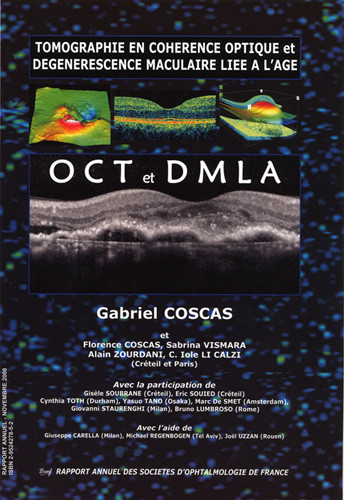
- Chirurgien-Ophtalmologiste, conventionné secteur 2
- Membre de la Société Française d'Ophtalmologie
- Ancien Assistant des Hôpitaux
- Ancien Praticien Hospitalier
- Ancien attaché chirurgical à la Fondation A. de Rothschild
- Chirurgien à la clinique de la Muette
- Chirurgien à la Clinique Jouvenet
- Diplôme Médecine et Chirurgie en 2000
- Spécialiste en Ophtalmologie en 2004
- Diplôme Inter Universitaire de « Pathologies et Chirurgie Orbito-Lacrymo-Palpébrale » en 2008
- Diplôme Universitaire « Imagerie rétinienne et traitements maculaires » en 2009
- Diplôme Universitaire « Oculoplastie esthétique » (CUOPE) en 2024
- Formation de Médecine, Art& Beauté lors de Function&Aesthetics Masterclass en mai 2024
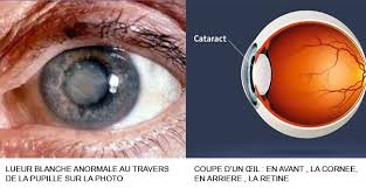
Traitement de la cataracte
Spécialiste depuis plus de 20 ans en chirurgie de la cataracte
- La cataracte est une pathologie induite par une opacification progressive du cristallin, qui provoque une baisse de la vision progressive de loin avec perte des contrastes.
- Cette pathologie touche la population à des âges différents et est normale après 55 ans.
- La cataracte est due à une perte de transparence du cristallin, la loupe de l’œil, qui empêche la lumière de le traverser correctement
Quels sont les symptômes de la cataracte ?
- Vision floue, le plus souvent de loin
- Perception atténuée des contrastes
- Vision dédoublée
- Gêne à la lumière (photophobie) lors de forte luminosité (soleil, phares de voiture…)
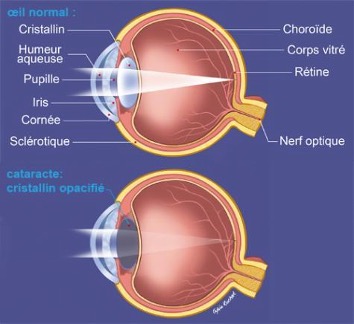
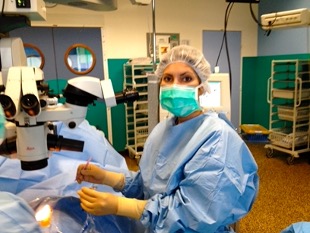
Quel traitement s’offre à moi ?
- Le traitement repose exclusivement sur la chirurgie
- Les collyres n’ont pas d’efficacité pour diminuer ou freiner l’évolution de la cataracte
- L’intervention de la cataracte, ou phacoémulsification, permet de remplacer le cristallin opacifié…
- La phacoémulsification se réalise au bloc opératoire sous anesthésie topique (superficielle) avec sédation du patient
- Elle dure une dizaine de minutes et est indolore
- Le patient ressort avec une coque transparente sur l’œil et devra effectuer des contrôles le jour après l’opération, à une semaine et un mois après, pour la correction optique définitive
A quel moment doit-on décider de l'opération ?
L’opération peut être décidée par le chirurgien lorsque la gêne visuelle (baisse de la vision de près ou de loin, sensation de brouillard, vision trouble, éblouissements…) limite véritablement la vie quotidienne, les activités professionnelles, la conduite automobile...
Que dois-je faire avant l'opération ?
Quelques jours avant l’opération, vous devez rencontrer l’anesthésiste pour décider avec lui du type d’anesthésie le plus adapté à votre situation. Un examen cardiovasculaire est également conseillé. La veille de l’intervention, il vous sera demandé de prendre une douche à la Bétadine et de faire un shampooing antiseptique. Différentes mesures de votre œil sont prises, afin de choisir le type et la puissance du cristallin artificiel (encore appelé lentille ou implant) spécifiquement adapté à votre œil. Une échographie de votre œil (Biométrie) est, en général, nécessaire pour cela.
Comment va se dérouler l'opération ?
L’opération nécessite une anesthésie le plus souvent «topique » (c’est-à-dire une anesthésie locale par administration d’un collyre anesthésiant) avec sédation du patient.
La phacoémulsification par elle-même est pratiquée sous microscope en milieu chirurgical stérile (hôpital, clinique, centre d’ophtalmologie).Elle consiste à retirer le cristallin opacifié à travers une toute petite incision et à le remplacer par le cristallin artificiel.
Elle dure une dizaine de minutes et est indolore.
Que dois-je faire après l'opération ?
Si l’état général du patient est bon et si l’anesthésie est légère, il est possible de quitter le centre de soins dans les heures qui suivent l’intervention.
Le patient ressort avec une coque transparente sur l’œil et devra effectuer des contrôles le jour après l’opération, une semaine et un mois après, pour la correction optique définitive
Quels seront les résultats pour ma vue ?
Le remplacement du cristallin opacifié par un cristallin artificiel spécifiquement adapté à votre œil doit permettre de rétablir très rapidement une vision tout à fait correcte. Une gêne peut toutefois être ressentie pendant les premières semaines qui suivent l’intervention.
Le cristallin artificiel standard peut, souvent, vous permettre de vous passer de lunettes correctrices en vision de loin OU en vision de près.
On peut corriger aussi l’astigmatisme par un implant Toric et parfois, si les conditions rétiniennes du patient le permettent, corriger la vision de loin, intermédiaire et de près en posant un implant Multifocal. La pose de cet implant est cependant limité à des patients ayant des caractéristiques spécifiques.
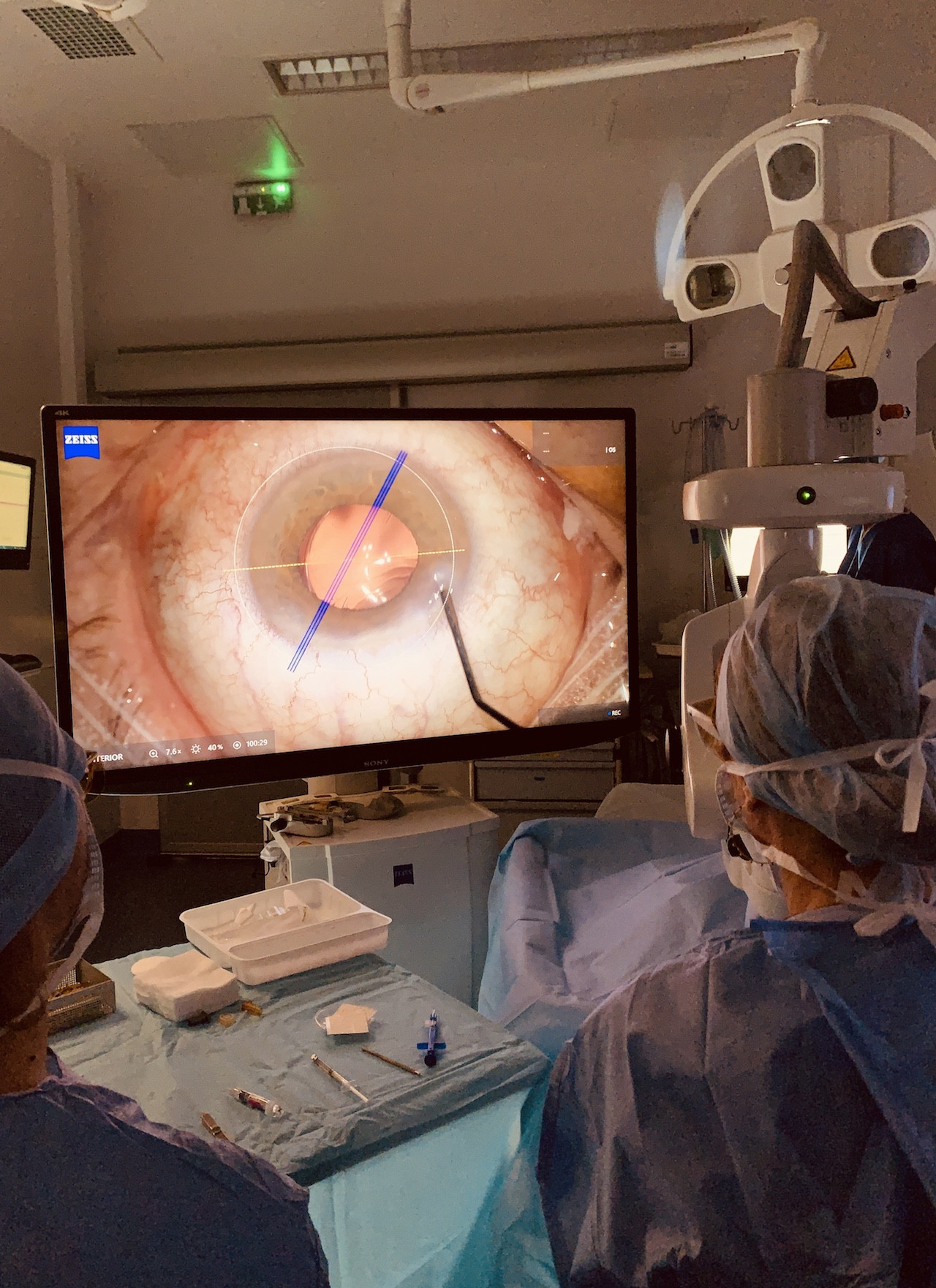
Y a-t-il des risques postopératoires ?
Aucune intervention n’est sans risque ! Cependant, la chirurgie de la cataracte est une opération de routine, parfaitement standardisée et suivie de très bons résultats. Les complications sont rares.
Vais-je devoir suivre un traitement ?
Lors de votre sortie, une ordonnance vous sera remise. Elle comprendra:
- Des gouttes à instiller dans votre œil opéré pendant quelques semaines après l’opération.
- Une protection oculaire (coque de protection) à mettre la nuit pendant 1 semaine.
La cataracte peut-elle récidiver ?
Non. Mais il est parfois possible que la capsule s’opacifie au cours des mois ou des années qui suivent l’intervention, entraînant à nouveau une baisse de la vision. On parle improprement de « cataracte secondaire ».
Cette baisse d’acuité visuelle peut être résolue définitivement, en ouvrant la capsule au laser. Il s’agit d’une petite opération indolore et très rapide, ne nécessitant aucune hospitalisation.
Une fiche d’information éditée par La Société Française d’Ophtalmologie est disponible sur le lien ici : cataract operation